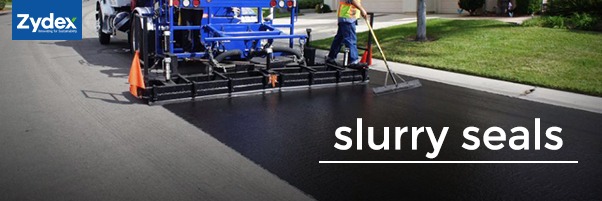Slurry seal is a homogeneous mixture of bitumen emulsion, water, well-graded aggregates and mineral filler, mixed as per a design formula, and applied to an existing asphalt pavement surface. Slurry seals are laid on the existing pavement, to seal cracks and voids, thereby making the surface weather tight and providing a new look. A slurry seal is similar to that of a fog seal, except that it has aggregates as a part of the mixture.
Slurry seals are used to remedy a broad range of surface distresses on various surfaces such as streets, drive-ways, airfields and parking lots, to extend the pavement life until resurfacing becomes absolutely necessary. Slurry seal applications are prominent on roads with moderate to low distresses and narrow cracks with no rutting. They seal the surface and provide flexibility and offer a rich black colour. They preserve and protect the underlying pavement surface and provide smooth surface with good riding quality.
Slurry seals, typically have three aggregate gradations:
1. Type 1 (fine)
This type has the finest aggregate gradation (smaller than 2.36 mm) and is used for filling small cracks. They are used as a preparatory pavement treatment and are limited to low traffic areas.
2. Type 2 (general)
This type is coarser than the Type 1 slurry, and is the most commonly used slurry seal type. It treats surfaces with moderate raveling, and improves the skid resistance of the existing pavement.
3. Type 3 (coarse)
Type 3 slurry seals consist of the coarsest gradation and is used to treat surfaces with slight depressions, to prevent water ponding and reduce the probability of hydroplaning.
Slurry seals are an economical and cost-effective solution, to build an all-weather, long lasting surface that provides better skid resistance and improved handling characteristics for drivers. Various factors such as traffic, weather, location and existing pavement conditions need to be taken into consideration before deciding on the slurry seal application. Typically, roadways are treated with slurry seals every 5 to 7 years.
Slurry seals are laid using a slurry truck, which holds various compartments to hold aggregates, water, polymer modified emulsion, and additives. These are the mixed in an on-board mixer and the slurry mixture flows out the rear of the truck onto the pavement. Paving crew follows the truck to provide assistance by ensuring that the mixture spreads properly, correcting uncovered areas and keeping the mixture from flowing over the sides. Sometimes, a fabric is dragged behind the slurry truck to ensure a smooth texture on the surface. Once laid, slurry seals require 4 – 6 hours to dry, before the road is opened to traffic.
Slurry seal is a protective asphalt overlay that preserves the underlying pavement surface and provides significant environmental benefits, thus allowing us to take a step towards a greener & sustainable future.
NanoTac is a cationic bitumen emulsion additive that can be used in Slurry systems at 0.1% by weight, to improve the bonding and wetting attributes of the mixes. This ecofriendly and sustainable chemical technology leads to blacker looking slurry mixes with improved moisture resistance.







